But the love of wilderness is more than a hunger for what is always beyond reach; it is also an expression of loyalty to the earth, the earth which bore us and sustains us, the only home we shall ever know, the only paradise we shall ever need—if only we had eyes to see. Original sin, the true original sin, is the blind destruction for the sake of greed of this natural paradise which lies all around us—if only we are worthy of it. —Edward Abbey, Desert Solitaire1
take me to the apple breeder is Jessica Rath’s deceptively simple meditation on the future and the past of a single genus of fruit, the apple. The complex journey of this work is at once a flight through the pages of a book into a study orchard and breeding farm; from the “making” of science to the “making” of art; and finally to a point deep in the early story of our human becoming when we were simply a species among species, acted upon by our environment and acting upon it in turn.
For some time now, I have had stewardship of a small stretch of endangered riparian habitat in Southern California, but long ago, in my ecological dark ages, I lived in Tucson for a year. Edward Abbey was still in residence, giving off sulfurous whiffs of both environmental anarchism and misanthropic intolerance.2 But local Latina-makes-good Linda Ronstadt’s glorious paean to roots music, Canciones de Mi Padre, was proudly on the playlist of every radio station in town, and I was flummoxed to find that one of the big cultural attractions of the place, the “Desert Museum,” was not a doughty neoclassic building with oak-lined vitrines of sawdust filled revenants, but rather something more akin to a stroll park studded with living follies. Presenting a sampling of local flora and fauna, the message of the Desert Museum3 was sprightly and comforting: “These creatures are your neighbors, and here we have collected them up close and safely—both for you and for them, too!” I took this safety bit to imply that “out there” wasn’t out there anymore, at least for the (wild) animals. But, calling this desert zoo a “museum” seemed a bit premature to me, given the robust and dangerous wildness I sensed during those several sunsets I passed amongst the Saguaros in the open desert on the edge of town, careful to be quiet as the predatory slither and watchful hoot reigned in the rosy dusk. Did this museum sample these bits of habitat because they were judged to be both exemplary and imminently historical?
Seeds grow, cracking with insinuating filaments, sucking mineral moisture to form green tissues that rise to harvest the sun. On some whim of locking DNA, this tissue grows tall and straight—or weeping or whorled; its buds open early—or late; its blossoms fragrant—or not, blushed or pale. This one succeeds by making an irresistible appeal to an abundant pollinator. Or it doesn’t. No matter, here is another seed with a different mitochondrial contract. It lands in the right soil and times its tender tissue to the local weather. It bears a fruit—perhaps a lemon, or a rose hip or any of a number of heterozygous sexual reproducers (ourselves included). But in this case, it is an apple.
Ah, simple, one thinks, I know what an apple is, the grainy brown mush of a bruised Red Delicious as familiar as that first day of school (the ancient association of apples and knowledge, how far back it goes). But just what is an apple? Maybe it’s like porn—you know it when you see it. I hope you are laughing, but it is not an idle question if you look at it from the plant’s point of view. Culturally, we know an apple to be the stuff of myths religious (original sin), patriotic (Johnny Appleseed), and juvenile (an apple a day). Materially, an apple is not much bigger than your fist and sweet, but only if you have primarily encountered it in the average American market.
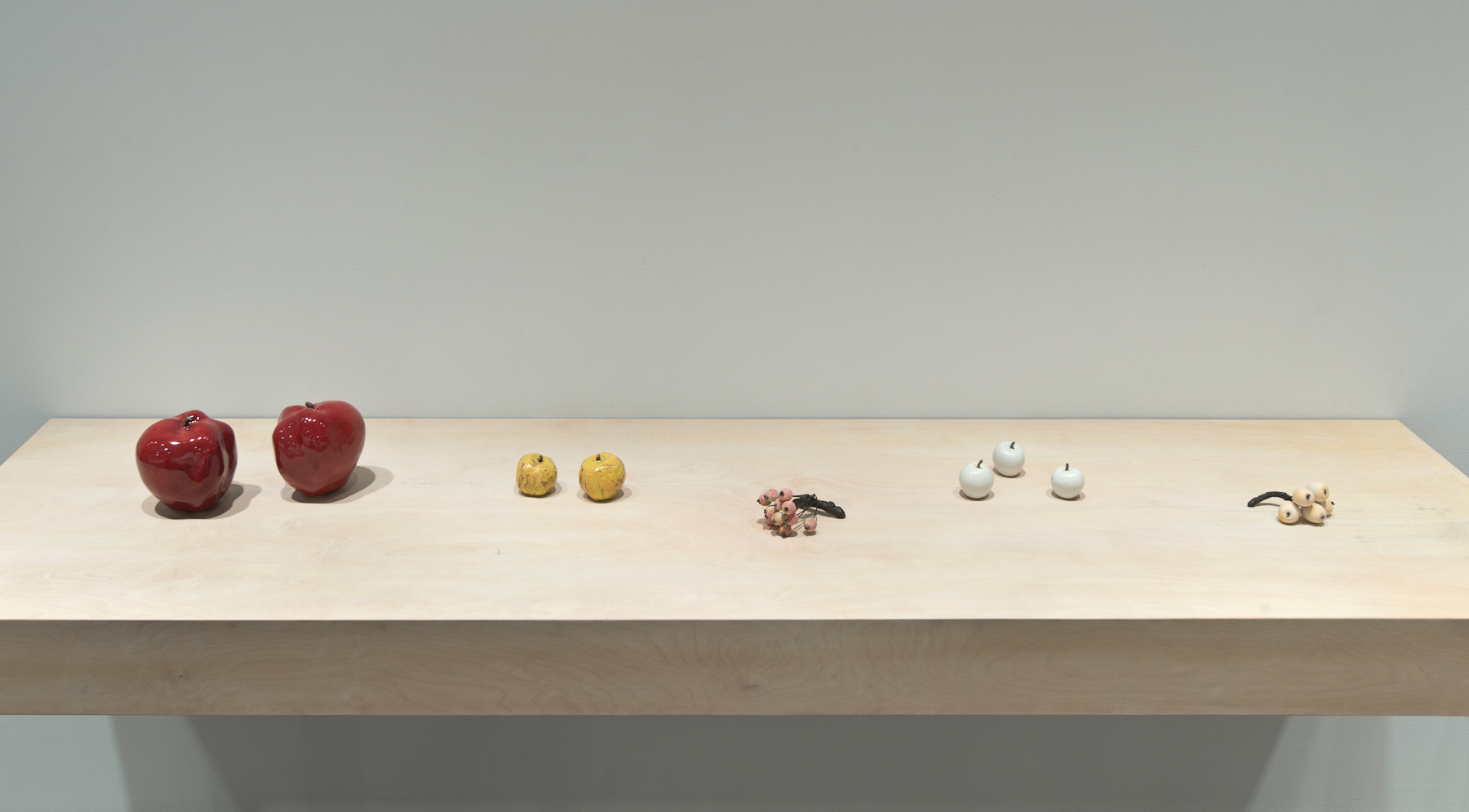
Jessica Rath, Ghost Orchard, installation view, Pasadena Museum of California Art, 2013. Photo: Brian Forrest.
Writer Michael Pollan sticks the domesticated apple’s sweetness firmly in the human hand and mouth. His 2001 book, Botany of Desire: A Plant’s Eye View of the World, examines four domesticated plant species and the contracts they have evolved with and through human agency for survival. His preface to the book runs in part: “These are stories, then, about Man and Nature. We’ve been telling ourselves such stories forever, as a way of making sense of what we call ‘our relationship to nature’—to borrow that curious, revealing phrase. (What other species can be said to have a ‘relationship’ to nature?)”4
This is a gentle retort to Edward Abbey’s rather more misanthropic figure/ground relationship: Figure—bad. Ground—good. Or to, say, Bill McKibben’s apocalyptic despair about both our responsibility for climate change and the threat it poses to our own and other species’ survival.5 Instead Pollan proposes a middle way, decidedly prelapsarian, that claims human agency as a part of nature, not apart from it. For Pollan, there is no original sin, and his retort to McKibben might be that starship earth continues on its very long journey, mistakes, losses, and change all part of the trip.
Pollan’s figure-ground relationship is exemplified by this description of John Chapman (Johnny Appleseed) in the opening essay of the book:
The peculiar craft you’d have caught sight of that afternoon consisted of a pair of hollowed out logs that had been lashed together to form a rough catamaran, a sort of canoe plus sidecar. In one of the dugouts lounged a figure of a skinny man of about thirty, who may or may not have been wearing a burlap coffee sack for a shirt and a tin pot for a hat. According to the man in Jefferson County who deemed the scene worth recording, the fellow in the canoe appeared to be snoozing without a care in the world, evidently trusting in the river to take him wherever it was he wanted to go. The other hull, his sidecar, was riding low in the water under the weight of a small mountain of seeds that had been carefully blanketed with moss and mud to keep them from drying out.6
For Pollan then, the figure-ground relationship of “Man and Nature” is actually a pair of figures—Chapman and the apple seeds he scavenged from middens of Pennsylvania cider mills—who together and interdependently go out to find new ground.
Each fruit of a wild apple tree, Malus sieversii, makes roughly seven shiny black assortment packs of DNA to pass on to the future. No two of these seeds will produce the same form or fruit as either of its parents, or even as its sister seeds. A healthy, full-grown tree might have thousands of apples on it every year, each bearing seven or more different DNA guesses for success. This is an excellent biological strategy for species survival and diversity, but each seed sprouted is only one figure on only local ground. The genetic variety in any handful of seeds ensures the species’ ability to offer some workable solution to the problem of growing fruitfully in almost any foreign field, but the plant risks extinction if it cannot spread. How does a figure rooted in its ground move?
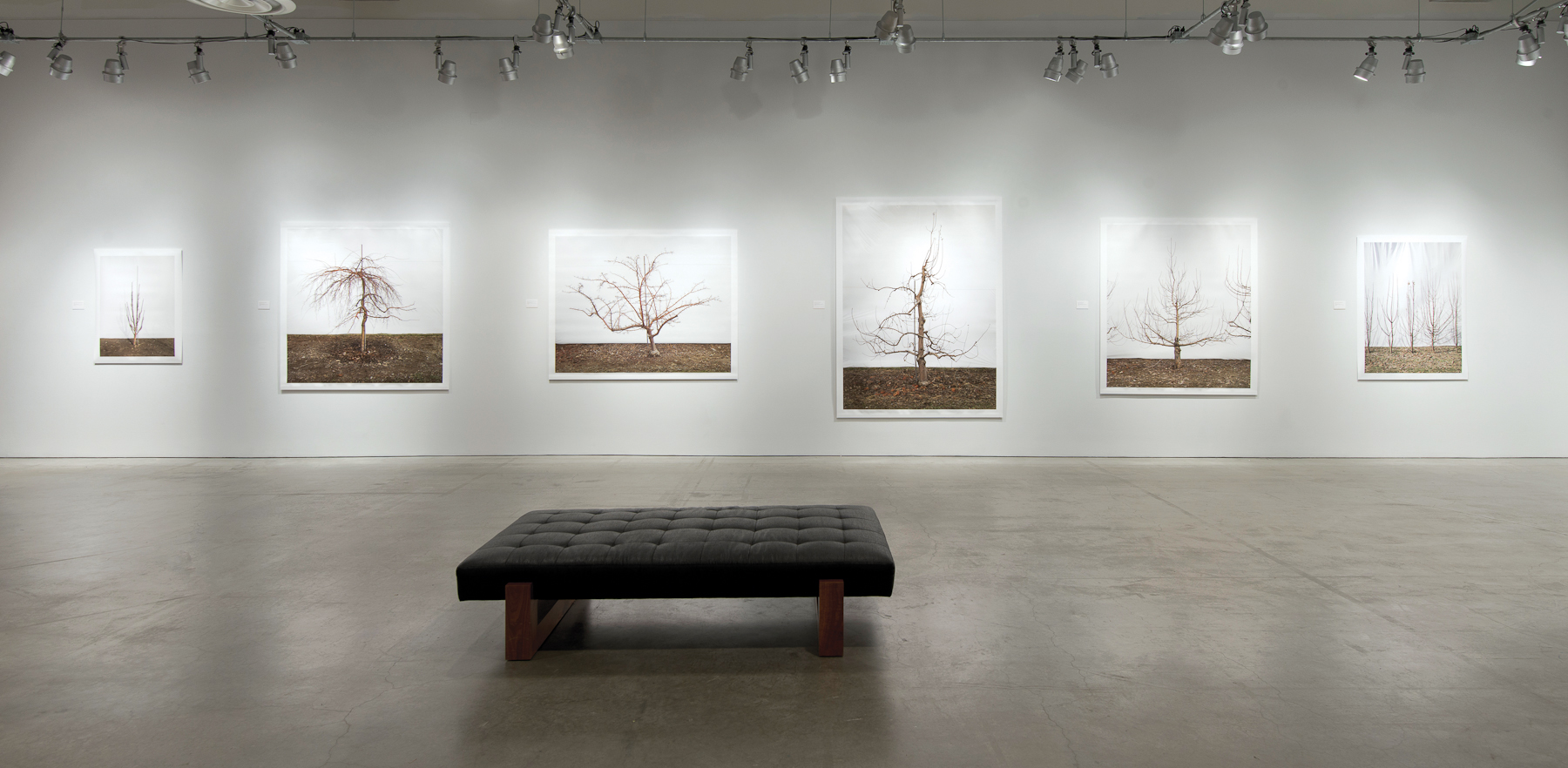
Jessica Rath, Apple Shadow, installation view, Pasadena Museum of California Art, 2013. Photo: Brian Forrest.
Compare this to the Malus domestica of any variety you might find in your market, or might have ever found in any market or orchard that bred a consistent type of fruit throughout human history. The farming of apples, like all orchard fruits, is largely dependent on what modern industrial agriculture calls “inputs”: fertilizers, pesticides and the like.7 Such chemical aggressiveness is necessary because these particular trees are in fact bricolage trees with very limited resistance because genetically they are all the same: “cloned bud wood” grafted onto a disease-resistant rootstock. Grafting is an ancient technique for plant propagation thought by some to have begun in China several thousands years BCE. While it seems odd to us that you can cut a living twig from one tree and slip it under the bark of another related tree and count on it to grow “true,” as they say—that is, produce fruit of the original variety that the cutting was taken from—the technique simply relies on a plant’s ability to root from cuttings, an ability we mammals have never evolved. To “clone” a plant, then, all you have to do is take a cutting and root it. In the case of a graft, the rooting takes place in the flesh of another plant, not in the dirt. Talk about figure/ground confusion! The price then of a consistent, sweet, and appealing (to humans) fruit is species diversity: all the cloned grafts of any cultivar contain the DNA of one single seed.
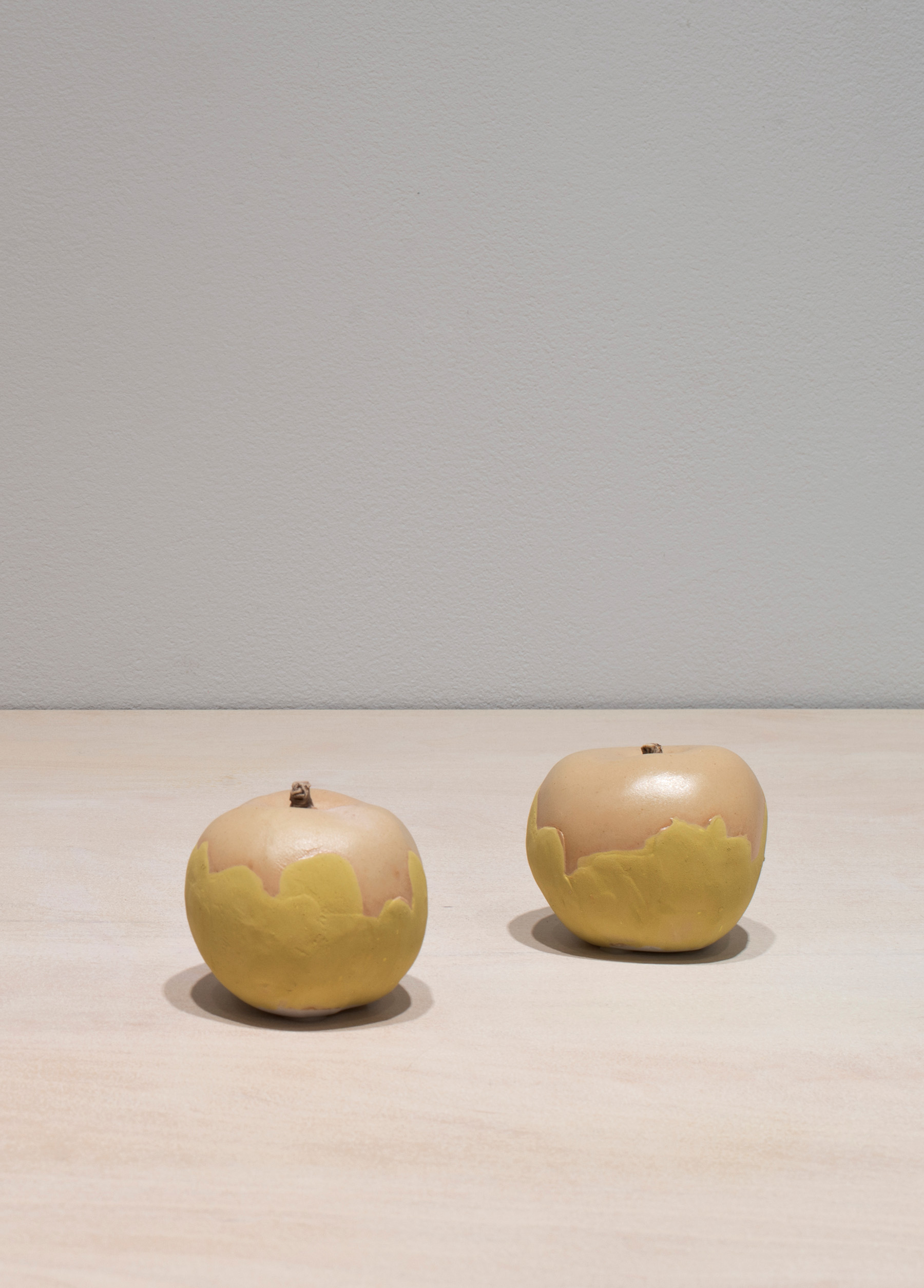
Jessica Rath, Roxbury Russet, 2011. High-fire glazed porcelain, two apples, 3 × 3.5 × 3.5 inches each. Photo: Brian Forrest.
Take the case of the Roxbury Russet, thought to be one of the first apple cultivars selected in the United States. A seedling tree—a “pippin” in the jargon of the trade—old enough to bear this appealing fruit was discovered in the town of Roxbury in the Massachusetts Bay Colony sometime prior to 1649. Smaller than your fist, and, despite the “russet” of its name, dusky and golden in hue, this apple was sweet enough for eating, stored well, and could be fermented into the popular hard cider of the day. As late as 1778, the variety’s popularity led Thomas Jefferson to plant lots of Roxbury Russets in one of his orchards at Monticello, but now, more than four hundred years since that single seed sprouted in the middle of what is now the city of Boston, the variety’s popularity has faded. Wikipedia attributes this sad demise to the Russet’s “dull and heavily marked face.”8 Humans are fickle allies.
Very few cloned grafts of the seed we know as Roxbury Russet are alive today, but two of them are in the orchard at the United States Department of Agriculture (USDA) ARS Plant Genetics Resource Unit (PGRU) in Geneva, New York, near Cornell University. Pollan makes brief mention of this extraordinary garden in his apple essay. The Russet is one of around 2500 heirloom cultivars collected initially by Philip Forsline for this USDA-sponsored salvage operation. The PGRU orchard contains two grafted clones for each apple variety, like the Roxbury Russet, threatened with extinction. Pollan calls the PGRU the “botanical ark”9 of apples, and there is no question that a flood is coming, and not just because of Bill McKibben’s climate changed “Eaarth.” No, far more pragmatic and frugal, the USDA might be said to be saving for a rainy day: the collapse of species diversity in a valuable food crop. If the genus Malus sieversii goes extinct in the wild, no doubt due to Abbey’s version of original sin, we will have only the genetic variety present in the grafted Malus domesticas left to us.
Let’s follow the Roxbury Russet into the gallery, because you will find it there among a group of exquisite high-fire vitrified porcelain apple sculptures that Rath, inspired by Pollan’s essay, spent several years making. The two apples in Roxbury Russet (2012) are each a slightly different shape, with matte, freckled manila shoulders that rise above an engulfing tide of yellow icing glaze applied paint-like from the bottom up. The sculpture certainly shows a “face heavily marked,” but it is never dull! These two sober-sided Roxbury Russets appear on a table next to a single grand Dulcina (2011), posing on her back like Goya’s provocative La Maja Desnuda, candy apple red and very shiny, bedecked with tiny white flecks that made me think of Vija Celmins’s night sky paintings. Nearby, another colonial-era survivor is represented by two apple sculptures collectively titled Yellow Bellflower (2011), which on close examination are two versions of the same cast, each turned to show a different face—if you will—to the viewer.
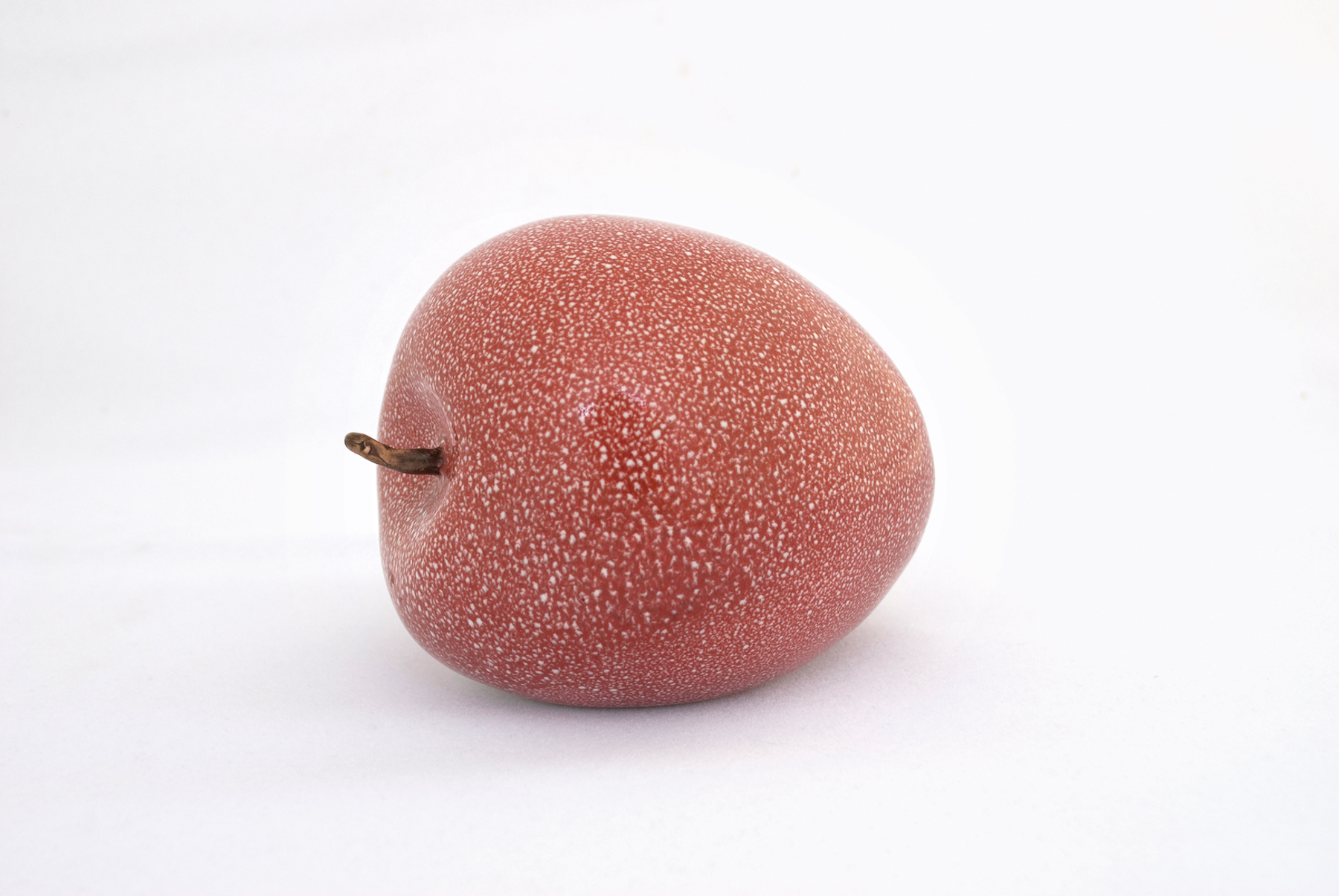
Jessica Rath, Dulcina, 2011. High-fire glazed porcelain, 6 × 6 × 6 inches. Photo: Brian Forrest.
Across this table and another, arrayed without benefit of protecting vitrines, spreads Rath’s stroll park of porcelain apple follies, some as small as the tip of your thumb, for example Sunset Cluster (2012) or PI 588933.12 (Unnamed Cluster) (2011), and others as large as the cupped hands of a giant—the fabulous Deacon Jones (2012) larger than a newborn human’s head. After her first visit to Geneva, Rath brought home dozens of different apples from the ark and made many models until she felt she had rendered the vital presence of each of these nine. Rath tells us that each of the nine apple sculptures is “life size,” a question posed again elsewhere in the gallery. Then she spent two years making the porcelain casts and designing and perfecting each individual high-fire glaze. Such figures! Surely this work is a labor of love akin to Chapman’s moving of apples from one ground to another or Forsline’s collecting, elegiac memorializer that he was. It is undertaken with the exquisite patience of the many human plant cloners who judged a particular fruit appealing enough to domesticate.
Opposite the apples, a line of leafless trees marches in single file around the room. Photographed in front of taut white backdrops flooded in brilliant daylight, the trees are imposing in scale, some as large as seven feet tall. Sometimes as many as five trees are in a picture, and sometimes only one, but all are as rigidly excised from their background by the blank white curtain behind them as is possible short of being plucked from the earth. These figures are never allowed to recede into the camouflage of distance or into the grouped diffusion of fellow flora. Not unlike the portrait work of Richard Avedon, these trees, fixed somewhere between portraits and specimens, surrender themselves up to our parsing gaze.
This is not the first time Rath has offered us a very close examination of the physical body of a fruit tree, and in a related indexical form. In 2009, Rath debuted her monumental Tree Peel, a full-size latex cast of an ancient and dying apricot tree found in her backyard in Los Angeles. The latex cast of the tree’s surfaces was turned inside out and sutured back together over a padded steel armature, spongily replicating the presence of the real tree, warts, termites, and all. In the Ben Maltz Gallery at Otis that year, the tree’s tumescent and grubby sallowness woozily reached toward the skylight, rooted to a simple black plate on the floor, repulsively uncanny.
The photographic trees are not titled by cultivar as most of the apples are, but rather in a way that initially seems wistful or poetic. Against their photographic forcing, titles like Sisters Smiling (2011) or Clone Weeping with Resistance (2011) beg a kind of recognition of their emotional state or demand sympathy for their plight. We are at once offered an imperial scrutiny of each tree in every visible particular and, simultaneously, a decidedly emotional entry into some sort of anthropomorphic interiority. This is a very complicated viewing experience.
In fact all five of the photographs called “sisters” are, in a sense, social: that is, the trees appear in groups. In Sisters Smiling, five trees “smile,” that is, each branch tips up at its end like the corners of a smiling mouth. But by the last photograph, Sisters Weeping (2011), two trees with draping limbs lean toward and mingle with each other, as if embracing. All the other social sisters—Sisters Normal, Sisters Small and Different, and Sisters Columnar with Difference (all 2011)—hang adjacent to this last sad pair of trees.
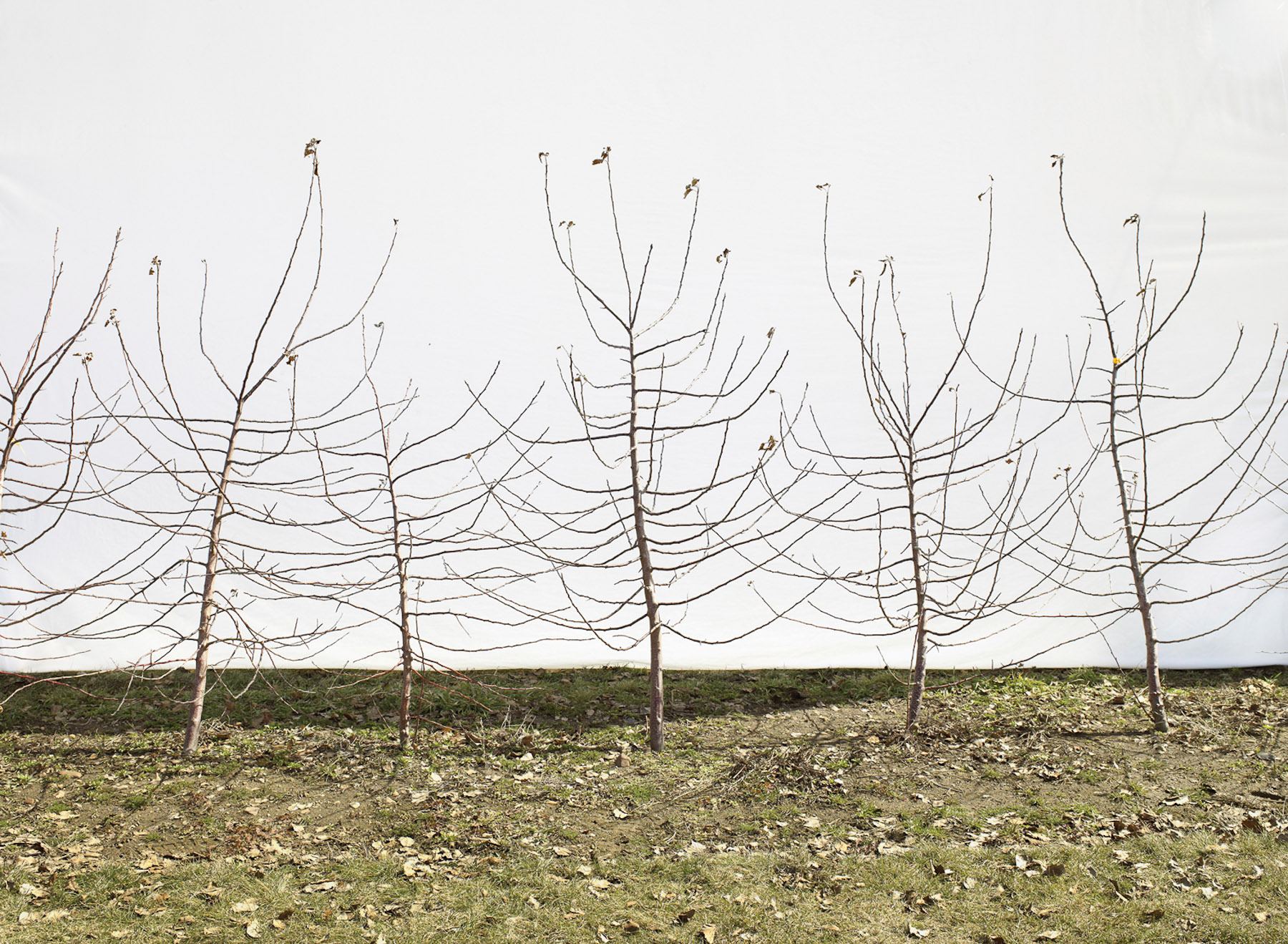
Jessica Rath, Apple Shadow (sisters smiling), 2011. Premium inkjet print, 36 × 48 inches.
In between the weepers and the smilers are six other photographs titled “clones,” a photography joke I could not help but laugh at. Each “clone” shows a single and singular tree, as all grafted fruit trees are. Clone with Central Leader (2011) is the largest of these. Looming more than seven feet tall, it begs Audubon’s “Double Elephant Folio” question: Are these life size? Clone with Central Leader also brings to mind that incomprehensible Lucas Film rumble, Star Wars: Attack of the Clones. As if its scale and title were not enough, covering this clone’s feet is a litter of dead apples, and I am suddenly transported to Dorothy’s side as the mean, scary apple trees are cleverly provoked by Scarecrow into providing sweet nourishment. Here between Rath and Geneva, I am in Oz, well and truly fed.
John Ruskin in Modern Painters (1843–60) helps me identify these titles as a species of poetry, employing the rhetorical mode that he called after Aristotle “the pathetic fallacy.” Encyclopedia Britannica defines this as “the poetic practice of attributing human emotion or responses to nature, inanimate objects, or animals. The practice is a form of personification that is as old as poetry, in which it has always been common to find smiling or dancing flowers, angry or cruel winds, brooding mountains, moping owls, or happy larks.”10 The fallacy is pathetic in the sense of pathos, which persuades through emotion, evoking sympathy or pity.
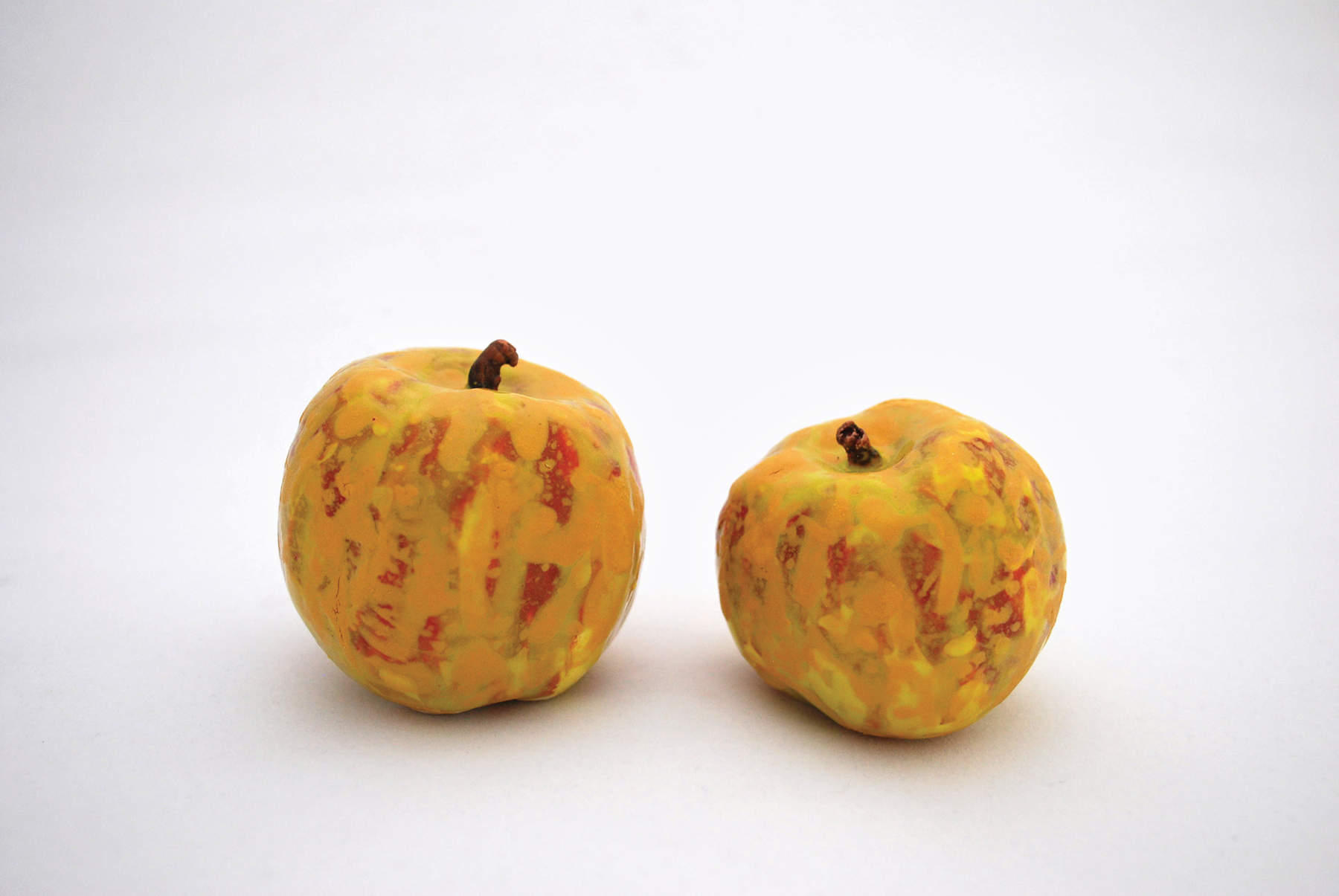
Jessica Rath, Drap d’or gueneme, 2011. High-fire glazed porcelain, two apples, 3 × 3.5 × 3.5 inches each.
Did Chapman feel pathos for his apple seeds? Is this the nature of “man’s relationship to nature,” to return to Pollan, or Abbey’s “love of wilderness” and “loyalty to the earth?” If any of this genuine feeling is fallacious, it can only be in the narrow scientific sense of proof, that is, if not actual causes, these genuine sentiments are corollaries of diverse species’ mutual appeal to each other for survival. History, in this sense, can be described as a continual struggle for method.
As you might have guessed, there is also a very literal read of these titles (and the images), as pragmatic and frank as the USDA might ever want them to be. Sisters are pippins—seedling trees of a single pollinated cross. Clones are grafted trees. Weeping, spreading, and columnar, of course, all refer to form. I am not sure smiling is a term of art, but it certainly is descriptive. And all this brings us to what Rath found when she went to the PGRU and Cornell: the future of the apple—contained in a living museum, yes, but adjacent to a breeding nursery—robust, varied, and productive, a pretty good bargain for a pile of seeds.
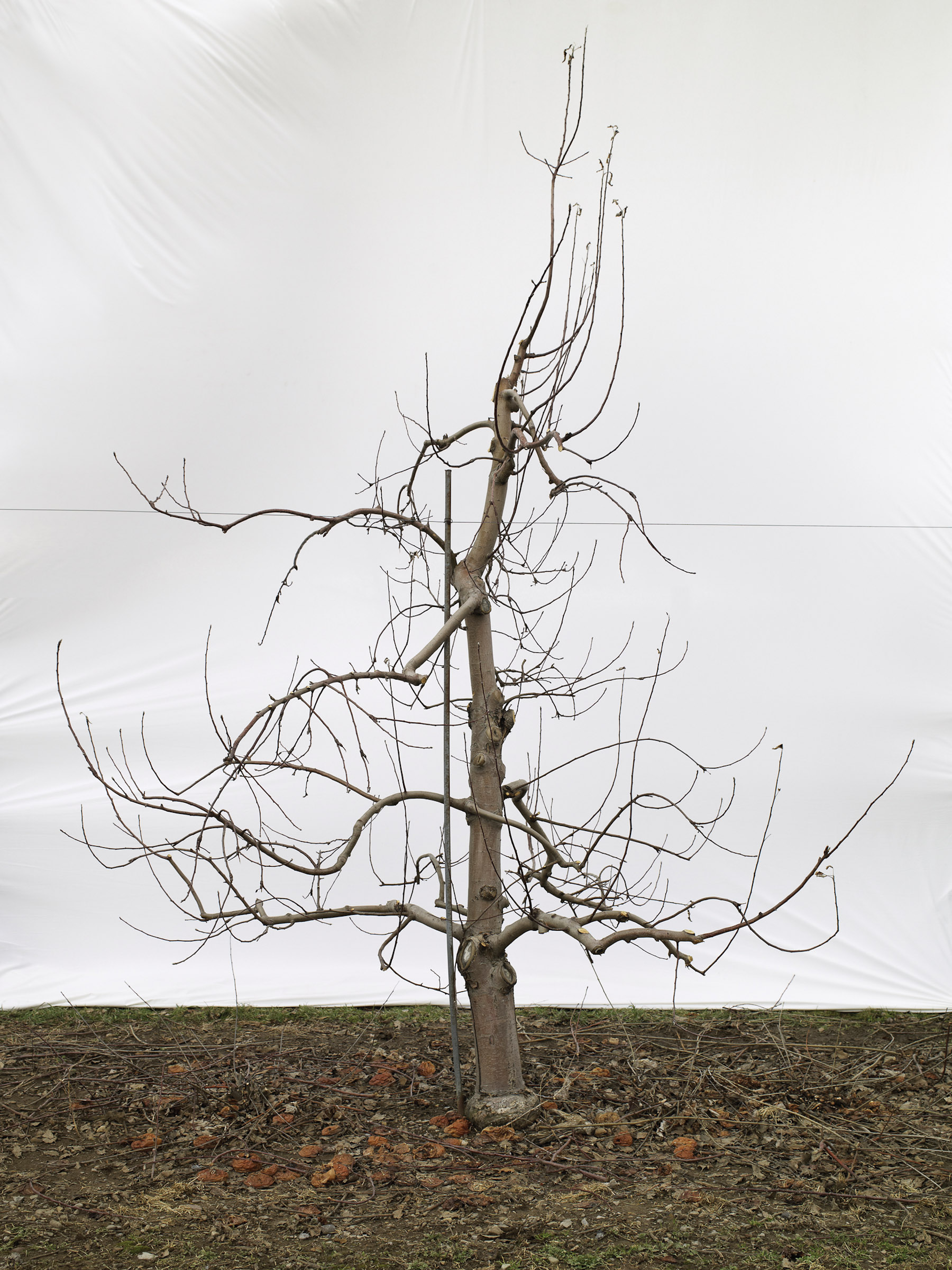
Jessica Rath, Apple Shadow (clone with central leader), 2011. Premium inkjet print, 60 × 80 inches.
To the figures Chapman and Forsline (and, of course, Rath), we can now add another apple ally: Dr. Susan K. Brown, the apple breeder of the show’s title. Her work and that of her colleagues is to take the genetic treasure trove of the PGRU historical collection and propagate new varieties of apples with resistances to many kinds of threats. The USDA is anticipating the rainy day of any single clonal variety’s collapse due to pandemics, such as HLB or Citrus Greening Disease, which is currently threatening commercial citrus orchards in the United States. In anticipation, Brown is cross-pollinating existing apple varieties wild and domestic at her Cornell nursery, cloning the most promising of these and trying them out in different growing situations and on different market tastes. Prelapsarian? Maybe not, but pragmatic and evolutionary.
The last extensive stand of wild apple forest, Malus sieversii, is in southern Kazakhstan. Each seed-grown tree is unique, and in their grouped diffusion they present a manifold array of form and flavor and survival options. They are also robustly healthy. Still, by all accounts this forest is diminishing rapidly, falling not to pandemics and pests, but to the pressures of human population growth, a form of Abbey’s “blind greed” that may not be blind, just very needy.
I’ve never been there, but I have a vivid picture of two figures in the scented wild apple woodland of my imagination. They stand on the same ground but 100 or 200 years apart. The earlier one—name him Audubon, Darwin, or even Linnaeus—describes and names and collects what he sees, killing what he collects because in the face of such abundance, what does the loss of this single example matter. Its bones will be apotheosized into a cultural life in the minds and places of men. The later figure—named Forsline or Brown (or many others throughout history unknown to you or me)—also describes and names what she sees, but is very careful to collect the living tissue in order to propagate and save it. Of course, this last figure is a modern-day, scientifically armored version of the most ancient greedy plant lover of them all: the farmer.
Now if we can only figure out how to domesticate the weather, perhaps our flood losses won’t be so great.
Ellen Birrell is an artist and lemon farmer. She is one of the co-founders of Project X and X-TRA. She edits and writes on a Macintosh computer.
